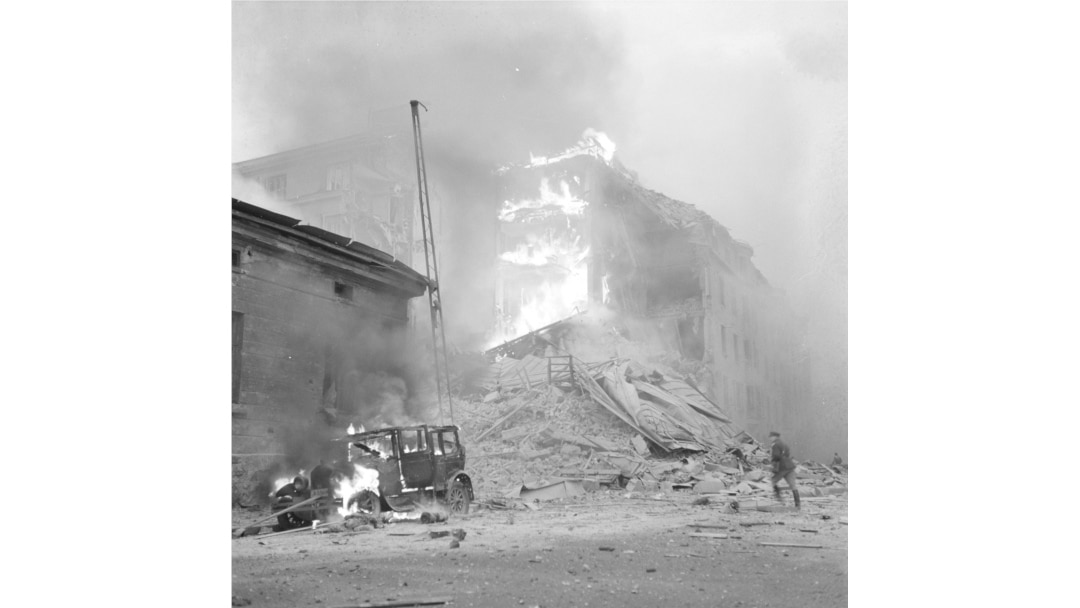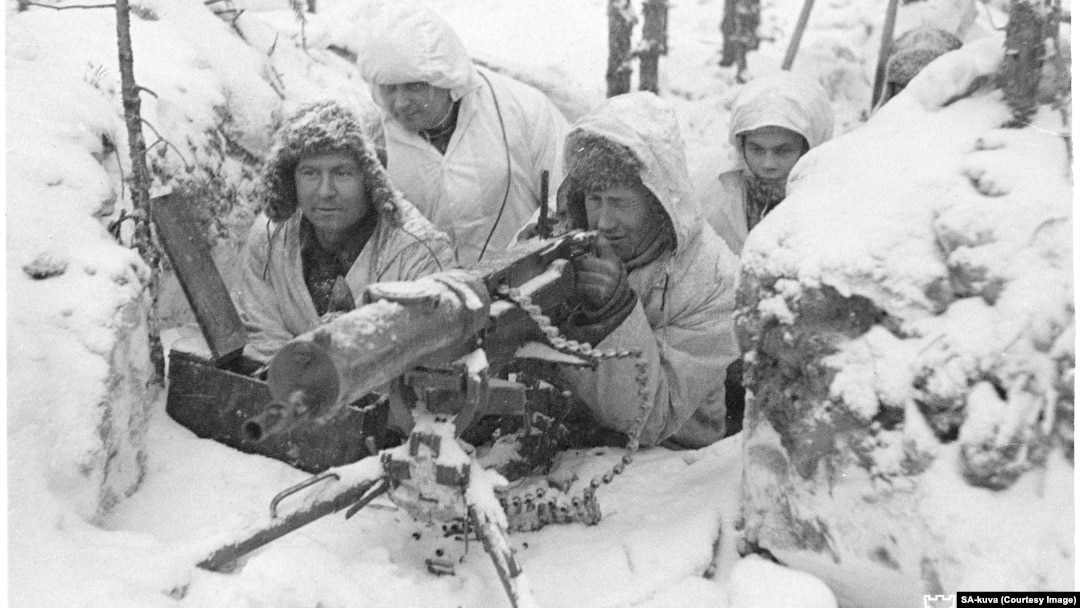
Shattered buildings and a car burn in Helsinki after an air raid on the opening day of the Winter War.
On November 30, 1939, nearly half a million Soviet troops stormed into Finland, beginning what would become known as the Winter War. The surprise attack came after the Kremlin, fearing a possible Nazi offensive through Finland, had insistently called for a land swap that would have pushed the Finnish border away from Leningrad (now St. Petersburg). Wary of Soviet intentions, Finland’s government refused.
Soviet planners assumed an easy victory in time for Josef Stalin's 60th birthday on December 21. It was not to be.
Although the Red Army would eventually win the war, the defeat of the country of just 3.7 million people came only months later -- and at a terrible cost.

A woman weeps as Helsinki residents file into a bomb shelter.
These pictures are some of the approximately 7,000 images of the Winter War from the Finnish Defense Forces archive that were digitized and released to the public in 2013.
Buildings burn in a suburb of Helsinki.
Amid an international outcry over the unannounced attack on Finland, Soviet Foreign Minister Vyacheslav Molotov claimed on the radio that planes were dropping food supplies -- rather than bombs -- to hungry Finns.
A Soviet plane on a bombing run.
A gas mask being squeezed onto a military dog. There were widespread but ultimately unfounded fears the Red Army would use poison gas during the invasion.
Soviet tanks (on road in background) advance into Finnish territory on December 17.
An artillery shell explodes near a farmstead during a Soviet advance.
A Red Army tank rolls in Finland. The underequipped Finns initially struggled to counter the Soviets' armored columns.
One cheap anti-tank weapon the Finns devised were Molotov cocktails (pictured) made of gasoline and tar.
Showing their dark sense of humor, the fighters named the firebombs after the Soviet foreign minister as a "drink to go with the food" that Molotov had claimed to be dropping on Finland. Thus giving birth to an oft-used weapon in conflicts through the decades since.
A downed Soviet plane being picked apart by a Finnish patrol.
Much of the weaponry used by the Finns was captured from Soviet forces.
Although outgunned and outnumbered, Finnish fighters used the few advantages they had with devastating effect.
Dressed in white camouflage, the defenders were almost impossible to see among snow-dusted trees.
The invading Red Army troops initially wore dark uniforms, making them easy targets for Finnish sharpshooters.
Simo Hayha, a Finnish sniper dubbed "White Death."
Professional farmer and hunter Simo Hayha reportedly killed more than 500 Soviet soldiers during the Winter War, before he was shot in the face and badly wounded by a Soviet sharpshooter. Late in life, when asked if he regretted killing so many young men, he responded, "I only did what I was told to do, as well as I could." Hayha died in 2002 and was buried under a tombstone reading "Home -- Religion -- Fatherland."
Finns made extensive use of reindeer that enabled the fighters to slide machine guns and mortars through the forests in near silence.
In contrast, Soviet armor could be heard from kilometers away, and was largely reliant on the few roads that cut through the Finnish wilderness.
Dead Soviet soldiers lie in the aftermath of a devastating attack on a Soviet column on the Raate Road in January 1940.
As columns of Soviet troops and vehicles filed along forest roads, Finnish ski troops were able to stealthily move into position and destroy vehicles at the front and rear. With the road blocked the Finns could then encircle and destroy the trapped Red Army columns.
Wounded and freezing Red Army soldiers after capture in February 1940.
Piles of Soviet corpses lay in the snow after a Finnish attack.
In the years leading up to the Soviet invasion of Finland, the purge of the Soviet military during Stalin's Great Terror left the army's command structure in disarray.
A Finnish woman with a handgun in her homestead. For Finns, the war was a crisis that unified the people and morale among fighters was relatively high.
Finnish fighters peek out from a sauna during the war.
Finnish fighters take a moment to pose during the war.
In January 1940, Britain’s Winston Churchill said of the ongoing war, "Finland shows what free men can do.... Everyone can see how communism rots the soul of a nation; how it makes it abject and hungry in peace, and proves it base and abominable in war. We cannot tell what the fate of Finland may be, but no more mournful spectacle could be presented...than that this splendid northern race should be at last worn down and reduced to servitude worse than death by the dull brutish force of overwhelming numbers."
The frozen corpse of a Soviet soldier lies where he died.
Temperatures in Finland dropped below minus 40 degrees Celsius during the war. The Red Army at the time had a policy of not training its troops in temperatures lower than minus 15 Celsius.
Dead Soviet soldiers and vehicles riddled with bullet holes in February 1940.
One group of surrounded Soviet soldiers sent a message to their superiors: "We are dying, please pay our March wages to our families. Tell everyone that we died as heroes…we did not surrender."
Finnish officers with seized Soviet propaganda. The banner says, "Workers of the U.S.S.R.! Do not forget about capitalist encirclement. Strengthen our socialist intelligence [service and] help it destroy and uproot enemies of the people!"
A captured Soviet soldier wears a borrowed hat.
During interrogation, one prisoner recalled being told he was to "liberate our [Finnish] worker friends from capitalism." The soldier soon realized he had been misled: "I can feel in my own skin how we were welcomed by those we came to 'free.'"
A Finnish fighter scans the forest.
After weeks of devastating losses up and down the eastern edge of Finland, the Soviet command finally changed tactics and focused on capturing Helsinki in the country's well-defended south.
The cathedral in Vyborg, a city that lay between the U.S.S.R. and Helsinki, shattered during a Soviet air raid.
A town in southern Finland burns after a Soviet air attack.
Incendiary cluster bombs were used by the Soviets against Finnish settlements made of wood.
Finnish fighters retreating through Vyborg.
With overwhelming numbers, the Soviets began forcing back the exhausted Finns. In March 1940, as Soviet troops entered the suburbs of Vyborg, the Finns had little choice but to accept harsh Soviet terms for an armistice.
Finnish flags lowered at half-mast in Helsinki on March 13, 1940, after the peace treaty became public.
A town in eastern Finland being evacuated in March 1940 after its territory was handed over to the Soviet Union.
Accepting the armistice cost Finland 11 percent of its territory, including the country's second city of Vyborg. The Winter War left 25,904 Finns dead. The Soviets lost at least 126,875 soldiers.
Soviet leader Nikita Khrushchev later recalled "All of us -- and Stalin first and foremost -- sensed in our victory a defeat by the Finns. It was a dangerous defeat because it encouraged our enemies' conviction that the Soviet Union was a colossus with feet of clay."
Just over a year after the Winter War ended, Finland made the disastrous decision to join the Nazi invasion of the U.S.S.R.


